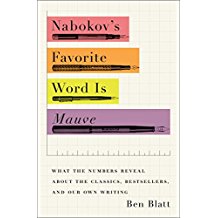Nabokov’s Favorite Word is Mauve: What the Numbers Reveal about the Classics, Bestsellers, and our own Writing, Ben Blatt, 2017.
Blatt had a good idea—use the recent digitization of books and statistical methods to ask some interesting questions about writing and writers. The book started out strong but fizzled out in later chapters. I was drawn to this book by the title, since Nabokov is one of my favorite authors and also by the introduction which told the story of how two statisticians, Harvard’s Frederick Mosteller and U. of Chicago’s David Wallace, used basic statistical tests of word frequency in the Federalist Papers to finally settle the authorship of twelve essays that both Madison and Hamilton claimed to have written. Blatt, using the Mosteller/Wallace methodology and other statistical methods (while ignoring important scientific issues of ‘power’ and ‘significant difference’)explores a number of questions about authors and their works. Some are fascinating, e.g. who has the lowest and the highest frequency of adverb usage in their novels? The lowest are Hemingway, Twain, Steinbeck and the highest frequency are Melville, Austen, and J.K. Rowling. Some of the questions are downright foolish, e.g. correlating the percent of the bookcover’s area taken up by the author’s name. A very interesting inquiry sought to identify authors’ favorite words that had to meet four requirements: the word must be used in at least half of the author’s work; it must be used at a rate of at least once per 100,000 words throughout an author’s books; it must not be so obscure that it’s used less than once per million in the Corpus of Historical American English; and it is not a proper noun. For Nabokov, that word was ‘mauve’ which was 44x more common in his eight books than in the Corpus. Some fascinating observations, but not worth the overall effort.



